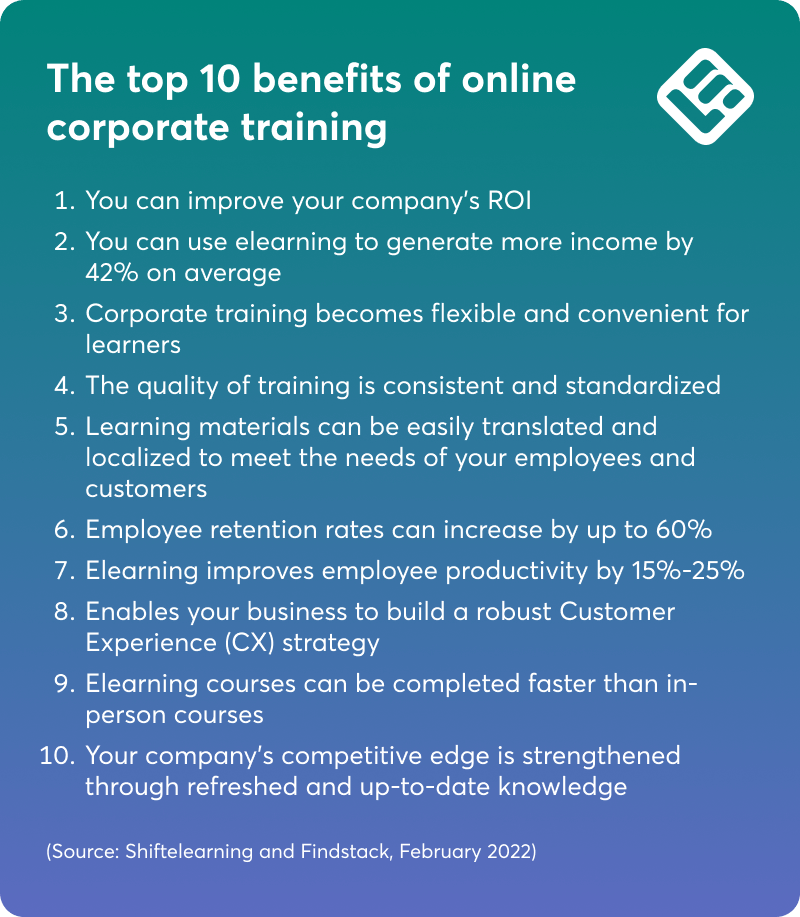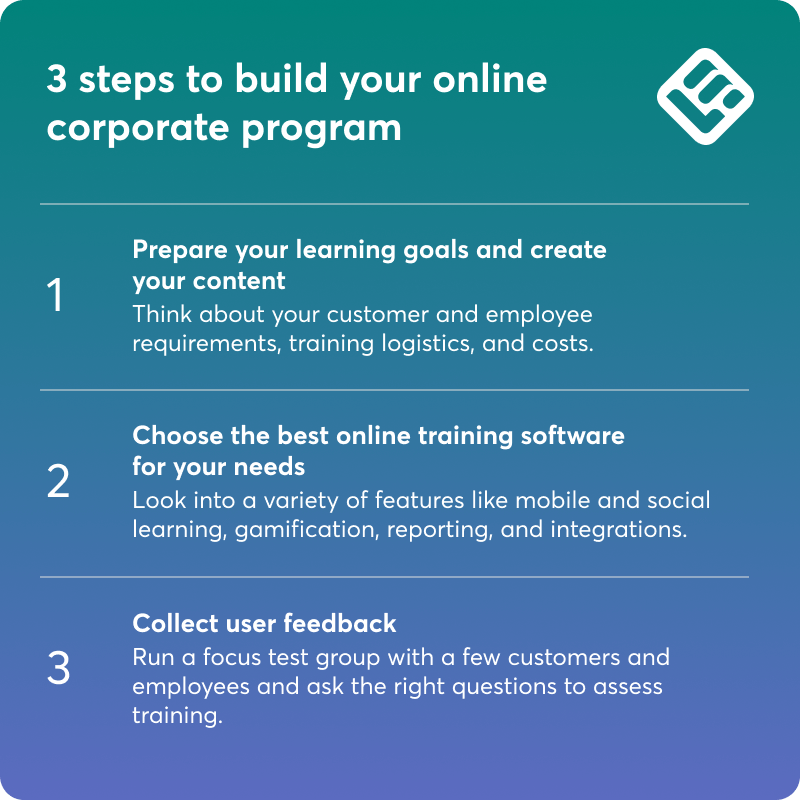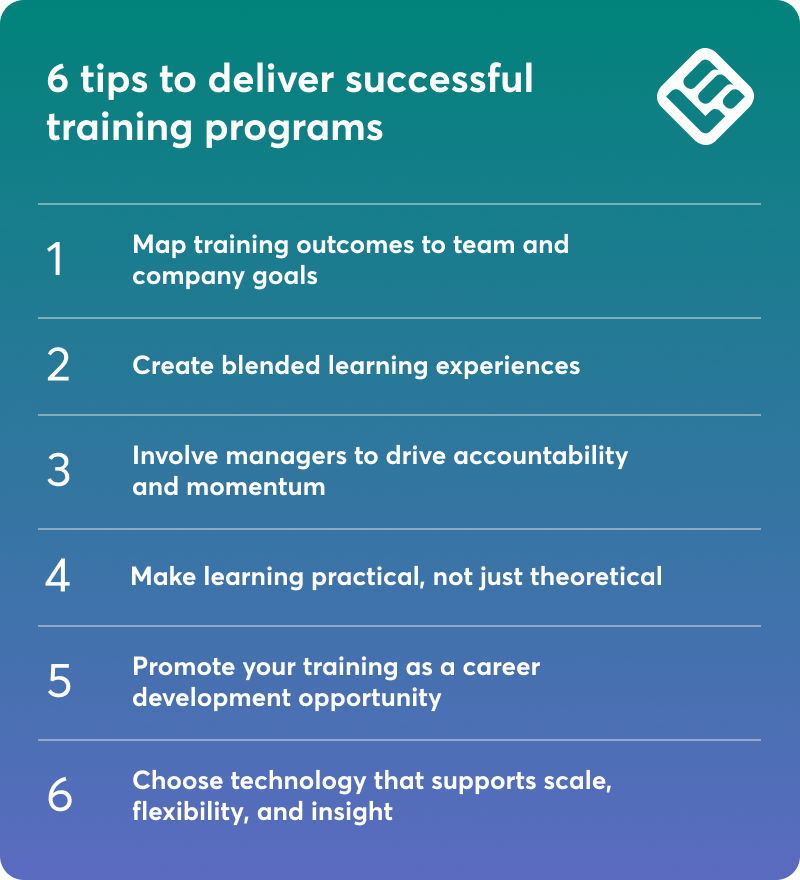Table of Contents
The first rule of a sustainable business is that “it costs five times as much to attract a new customer than to keep an existing one.” The key is clearly in retaining customers and building a loyal relationship with them.
And you may now ask, “Ok, easier said than done? How can I improve the customer experience for my business? What can I do to keep my customers happy and loyal? How can I invest in customer retention?”
Online corporate training programs are the answer you are looking for.
This article will put things in perspective for your business and guide you through the steps of creating a great online corporate training program to develop both your business and your workforce, and reach the much-desired improved customer experience.
What is online corporate training?
Online corporate training is a training method provided and delivered over the internet for 360-degree business learning and development, for both customers and employees.
Organizations choose to adopt online corporate training programs to ensure that their employees have the essential skills they need to carry out their jobs effectively, enabling the business to evolve and develop.
Besides, you may also create an educational corporate learning program to familiarize your customers with best practices about specific products or services that they have purchased from your business.
Corporate training examples
You can create strategies for customer onboarding with corporate training programs to welcome new clients, allowing them to take courses on how to better use your products or services at their own pace.
You can even implement or sell a full certification program for your customer service department to onboard new hires in the department and thus ensure optimum service for your customers.
A successful corporate training program that has assessed your business stakeholders’ needs offers the most cost-effective and quickest way to transfer knowledge through synchronous or asynchronous e-learning courses, or a blend of both.
For those organizations that are seizing the power of online corporate training, the results are profound. A study by IBM showed that for every $1 spent on online learning, a company gains $30 worth of productivity. This is great news for enterprises of any industry and size.
Solutions for corporate digital training
As soon as you assess the training needs of your learners, you will need an online learning platform, a modern corporate LMS, to build and implement your online corporate training program. LearnWorlds is the ideal solution for your company.
Apart from the flexibility and ease of use of creating your corporate academy and online courses within the academy, LearnWorlds also comes as a fully white-label website solution that allows you to present your business to your learners in the best possible way.
The benefits of online corporate training
Here are some insightful data on the benefits of providing corporate training courses online:

(Data retrieved from Shiftelearning and Findstack, February 2022)
Different types of corporate training programs you can implement
Choosing the right training programs depends on your organization’s goals, industry, and workforce needs. From onboarding new hires to developing leaders, each type of corporate training serves a distinct purpose.
This comparison table outlines the types of corporate training programs, helping you assess which formats and audiences best align with your learning strategy.
How to build your corporate digital training strategy
What most organizations are doing is bridging their employee training and customer education gaps through the induction of an online learning management system, also known as LMS, into their corporate training program. Sometimes they do this as part of their existing training program.
As we have mentioned above, in the quest for finding the best corporate training platform, though, not just any software will do. The online training system you are using should accommodate your employees’ needs and your business goals for the long run.
In short, you will need to have a corporate learning strategy in place.
Your online corporate training program needs to follow a solid plan. Come up with one while going through the following steps.

1. Prepare your learning goals and create your content
You don’t have to be an instructional design expert to put together your corporate training programs. You can set up your customer and employee learning goals using the following ideas to guide your thinking:
Customer & employee training requirements
Identifying customer and employee requirements ensures your content is relevant, engaging, and effective. This step helps you align your training efforts with actual gaps in knowledge or performance and tailor the learning experience to different audiences. To do that, you can:
Here’s an example of how LearnWorlds’ interactive video editor works:
To be able to add more complex or advanced learning units into your corporate training, like the interactive video, you are going to need a handful of suitable tools that a learning platform or an LMS can support, including Tin Can, SCORM, and HTML.
Online corporate training logistics
Once you’ve defined your training goals and requirements, the next step is figuring out the logistics. That means planning when and where learners will engage with the content.
If the training is quiz-based and only includes questionnaires, you can provide user logins to your employees to access and complete the training material in asynchronous learning, from the comfort of their homes.
Creating the training content
After deciding on the training goals and the way of delivery, you should be ready to create the content. Creating online corporate training courses takes considerable planning and investment.
You will need to validate your online course idea:
💡Check out our guide on how to create an online course for a more detailed walkthrough on creating educational content.
💡Here are some additional resources to help you out with creating your training content:
Evaluating the training cost
Each LMS and online course platform has different pricing. Their price for online corporate training depends on many elements eg LMS features and the number of seats, users, or licenses they come with it, and so on.
What you need to do is calculate the number of your learners (employees and/or customers) or how many seats and licenses you will need, and choose the pricing plan that accommodates that number. Then find out how the LMS you choose charges for it. Some charge by active users while others charge by subscription.
2. Choose the best online training software for your needs
Once you are finished setting up your learning goals, you need to search for the training software that can accommodate them in the best possible way.
An LMS for businesses or an online course platform are viable solutions for your customer or employee training program. Both have the potential to improve your learners’ engagement, satisfaction, performance, and generate more revenue for your business.
When searching for either one, though, it’s important to ensure that it ticks off all of your preferred LMS features, because they can have a huge impact on the overall effectiveness of your online corporate training programs.
An LMS should be able to offer a high-quality corporate training solution through the following capabilities.
Mobile learning
Providing the possibility for your learners to access learning at any time and place using mobile devices eg smartphones, tablets, etc.
A mobile app builder counts as a huge plus. Mobile learning is growing faster than ever before. Learning is increasingly taking place via mobile devices instead of computers.
For your online corporate training to succeed, you need to implement a mobile-first strategy that reaches your learners wherever they may be.
Social learning
Offering social assessment opportunities to customers and employees, and the ability to share user-generated content.
For example, creating a community where they can compete with or learn from each other eg group discussions, chat rooms, and other peer-to-peer activities as part of an online learning community.
Content customization
Creating unique, relevant content and personalized learning paths for teams, employees, and managing training materials around your business needs.
This may include the white-label option or the ability to customize the design of the learning environment, including login pages and dashboards.
Gamification
Incorporating gaming mechanics to motivate your employees into interactive learning (eg badges, awards, leaderboards, and contests).
Research from The eLearning Guild shows that learners who participate in gamified online learning experiences score better in assessments and tend to have higher retention rates.
Intuitive UI/UX
Having an easy-to-use and modern user interface that keeps up with the technological trends makes the user experience a simple, creative, and enjoyable process. An intuitive UI design can help increase engagement at large. See an example from LearnWorlds’ Modern Course Player:

ILT classroom
Having the ability to carry out instructor-led classroom training is always going to be a favorable asset in the area of learning. Virtual instructor-led training activities as part of your online corporate training program can help you offer high-quality training to your learners.
Rich multimedia
Allowing the use of text, images, any type of video (recordings, screencasts, webinars), and the support of different content formats, including PDF, Google Docs, video files, HTML, and SCORM packages, can enhance interactivity.
💡See also: 6 best SCORM-compliant LMS platforms for 2025
Easy setup
Making it effortless for you to get your online corporate training courses up and running. The best way to ensure that you will have it ready easily and quickly is by choosing a cloud-hosted LMS that supports a high amount of traffic.
Advanced reporting
Showing reports on the online training activity, scores, user progress, and completion rates of your learners.
Detailed reporting on the employees’ and customers’ learning activity can give HR management and your customer success department accordingly, an overview of their performance. It can also help to track and measure the performance of your online training program.
Third-party integrations
Providing the ability to connect different systems, apps, and software together through third-party services (Zapier and WP SSO plugin) can enhance the quality of the online training you are offering.
Also, many e-commerce integrations can bring more value to your corporate training, giving you the ability to sell training like CRM, HRIS software, and Google Analytics.
Many good LMS options can cover these elements to varying degrees, offering a customized training solution. However, a large number of LMSs out there are pricey, while the majority don’t offer the flexibility to start your online school with them.
If you are unsure about which platform to choose, keep searching for that online learning platform or LMS that stands out in terms of cost-effective pricing, learning technology, and most importantly, the potential to offer the best learning experiences to your employees.
You can try LearnWorlds, as an all-in-one platform to provide online corporate training and see whether it fits into your company’s requirements.
3. Collect user feedback
Once you find the LMS that suits your training needs best, you can run a focus test group with a few customers and employees, as they will be the end-users taking the training.
A fast and efficient way to track and improve the performance of your online corporate training program strategy is by getting feedback through an online course evaluation survey.
The survey could be asking your learners questions about the product they are using.
Here are a couple of examples:
The number of questions is inexhaustible here, but you get our point.
Also, test what your employees and customers have learned from the training course through real-world examples. This should help you detect possible gaps in the learning content.
Being able to adjust the content easily and quickly, or carry out the appropriate changes using the training software that can do it, is a huge advantage for your business.
6 tips for successfully implementing corporate learning programs
Implementing corporate learning programs involves more than choosing the right content. It requires a clear process, stakeholder alignment, and tools that support scale and engagement.
These practical tips will help you set up effective programs that meet your business goals and your team’s learning needs.

1. Map training outcomes to team and company goals
Define clear learning outcomes that support broader business objectives like employee retention, compliance, or operational efficiency. When stakeholders see the connection, they’re more likely to support and invest in workplace training programs.
2. Create blended learning experiences
Design and implement a blended learning approach by combining online courses with live sessions, peer feedback, and discussion spaces. This model helps you:
3. Involve managers to drive accountability and momentum
Engaged managers help normalize learning as part of the workflow, not a one-off event. To build a culture of continuous development, encourage managers to:
4. Make learning practical, not just theoretical
Design content that reflects real-world tasks and challenges. Scenarios, simulations, and assignments that mirror the workday help learners retain and apply knowledge learned with workplace training programs. This practice boosts both learning outcomes and performance on the job.
5. Promote your training as a career development opportunity
Frame your courses as personal and professional growth tools, not just checkboxes. Showcase how learning paths support internal mobility, skill advancement, and leadership development. This messaging increases engagement, especially among high-potential talent.
6. Choose technology that supports scale, flexibility, and insight
The tools you use directly affect the success of your corporate learning programs. Look for a platform that makes it easy to build structured content, track learner progress, and adapt quickly based on feedback. A reliable enterprise LMS like LearnWorlds helps you deliver consistent, high-quality training, whether your team is on-site, remote, or global.
Create the best corporate training programs with LearnWorlds
To wrap it up for now, this is everything you need to build successful online corporate training programs. Ensure your learning goals and objectives are aligned with your overall marketing strategy for customer retention and loyalty, as well as with your organization’s departments handling customer requests (eg pre-sales and after-sales service, customer support, customer success).
In a world where nearly nine out of ten companies compete primarily on customer experience, it’s the organizations that take customer experience seriously who will stand out from the crowd and win customer loyalty.
It is also a team effort at the end of the day, so all your team members must be on board and aligned to create a great customer experience and facilitate your business growth!
Further reading
- How to Start an Online School in 2022 + Infographic
- Starting an Online Course Business from Scratch
- 7 Benefits of Building a Customer Education Program [Guide]
- How to Teach Online & Earn Money in 2022: Definitive Guide
- How to Sell Online Courses On Your Shopify Store (Guide)
- Introducing the Most Advanced Online School Site Builder
- 18 Amazing Outline Templates to use in Course Design [3 Downloadables]
- How to Create and Sell Profitable Online Courses: Step-by-Step Guide
Rosemary is LearnWorlds’ Content Marketing Manager. She has over 2 decades of experience in omnichannel marketing and content writing for the IT and SaaS industry. Her expertise lies in crafting effective content marketing strategies that attract, engage, and nurture customers, enabling LearnWorlds to reach its target audiences with precision.
Kyriaki is the SEO Content Manager at LearnWorlds, where she writes and edits content about marketing and e-learning, helping course creators build, market, and sell successful online courses. With a degree in Career Guidance and a solid background in education management and career development, she combines strategic insight with a passion for lifelong learning. Outside of work, she enjoys expressing her creativity through music.






